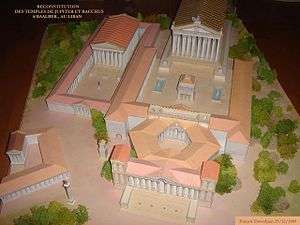Temple of Bacchus
| Temple of Bacchus | |
|---|---|
_5.jpg) | |
| General information | |
| Type | Roman temple |
| Architectural style | Classical |
| Location |
Baalbek, Lebanon Heliopolis, Roman Phoenicia |
| Completed | late 2nd or early 3rd century |
| Height | 31 m (102 ft) |
| Technical details | |
| Size | 66 by 35 m (217 by 115 ft) |
| Design and construction | |
| Architect | Unknown |
| Main contractor | Commissioned by Antoninus Pius |
Temple of Bacchus may refer to any temple to the Roman wine god Bacchus or to temples of other gods with which he was equated in antiquity, such as the Greek Dionysus. However, it often refers specifically to the most famous temple of Bacchus, located in Roman Heliopolis (Baalbek).
Heliopolis (Baalbek)
The Temple of Bacchus at Baalbek, a World Heritage site, is one of the best preserved and grandest Roman temple ruins in the world. It and its ornamentation served as an influential model for Neoclassical architecture.[1]
The temple was commissioned by Roman Emperor Antoninus Pius and designed by an unknown architect and built close to the courtyard in front of the larger temple of Jupiter-Baal.[2] The period of construction is generally considered between 150 AD to 250 AD.[2] When the temple complex fell into disrepair, the Temple of Bacchus was protected by the rubble of the rest of the site's ruins. The temple is slightly smaller than Temple of Jupiter and is 66m long, 35m wide, and 31m high.[2]
Its walls are adorned by forty-two unfluted Corinthian columns, nineteen of which remain upright in position standing 19 m high. The columns support a richly carved entablature. Inside, the cella is decorated with Corinthian "half-columns" flanking two levels of niches on each side, containing scenes from the birth and life of Bacchus. The adyton (inner shrine) stands above a flight of steps. Some historic Roman coins depict the structure of this temple along with Temple of Jupiter.[3] The storm god Ba'al was worshipped in this temple.[4]
The Temple is enriched by some of the most refined reliefs and sculpture to survive from antiquity.[5] The temple is surrounded by forty-two columns—8 along each end and 15 along each side —nearly 20 m (66 ft) in height. These were probably erected in a rough state and then rounded, polished, and decorated in position. The entrance was preserved as late as the XVI century, but the keystone of the lintel had slid 2 ft (1 m) following the 1759 earthquakes; a column of rough masonry was erected in the 1860s or '70s to support it. The 1759 earthquakes also damaged the area around the soffit's famed inscription of an eagle,[6] which was entirely covered by the keystone's supporting column. The area around the inscription of the eagle was greatly damaged by the 1759 earthquake.[6] The interior of the temple is divided into a 98 ft (30 m) nave and a 36 ft (11 m) adytum or sanctuary [7] on a platform raised 5 ft (2 m) above it and fronted by 13 steps.
In 1984, several ruins of Baalbek, including the Temple of Bacchus, were inscribed as a World Heritage Site.[8]
The temple is known for its impressive dimensions, richly decorated stone work and monumental gate with Bacchic figures.[8] The decorative stone carving includes rows of lions and bulls, which were motifs symbolically associated with the two deities.[9]
See also
Notes
Bibliography
- Sear, Frank (1982). Roman Architecture. UK: B T Batsford Ltd, UK. Retrieved 12 November 2014.
- Butcher, Kevin (2003). Roman Syria and the Near East. Los Angeles: J. Paul Getty Museum. ISBN 9780892367153. Retrieved 12 November 2014.
- Jessup, Samuel. Ba'albek (Picturesque Palestine, Sinai and Egypt) Ed. Appleton & Co. New York, 1881 ()
External links
| Wikimedia Commons has media related to Temple of Bacchus in Baalbek. |
- The Temple of Bacchus at Great Buildings
Coordinates: 34°00′22″N 36°12′15″E / 34.006079°N 36.204038°E
